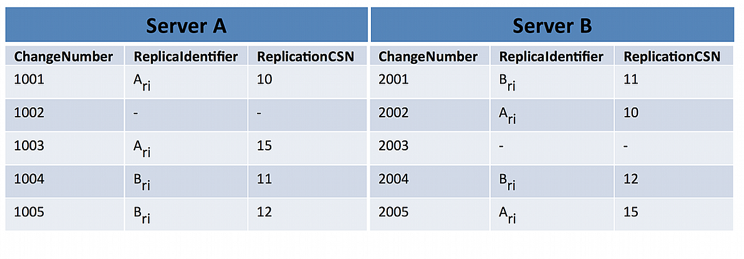PingDirectory server and PingDirectoryProxy server tokens
The PingDirectory server maintains a change log database index to determine when to resume sending changes (for ADD, MODIFY, or DELETE operations) in its change log. While a simple stand-alone directory server can track its resume point by the last change number sent, replicated servers or servers deployed in entry balancing environments have a different change number ordering in its change log because updates can come from a variety of sources.
The following figure illustrates two change logs in two replicated directory servers, server A and B. "A" represents the replica identifier for a replicated subtree in Server A, and "B" represents the replica identifier for the same replicated subtree in server B. The replica identifiers with a hyphen ("-") mark any local, non-replicated but different changes. While the two replicas record all of the changes, the two change logs have two different change number orderings because updates come in at different times.

To track the change log resume position, the PingDirectory server uses a change log database index to identify the latest change number position corresponding to the highest replication CSN number for a given replica. This information is encapsulated in a directory server token and returned in the get change log batch response to the PingDirectoryProxy server. The token has the following format:
Directory Server Token: server ID, changeNumber,replicaState
For example, if the PingDirectoryProxy server sends a request for any changed entries, and the directory servers return the change number 1003 from server A and change number 2005 from server B, then each directory server token would contain the following information:
Directory Server Token A:
serverID A, changeNumber 1003, replicaState {15(A)}
Directory Server Token B:
serverID B, changeNumber 2005, replicaState {12(B), 15(A)}